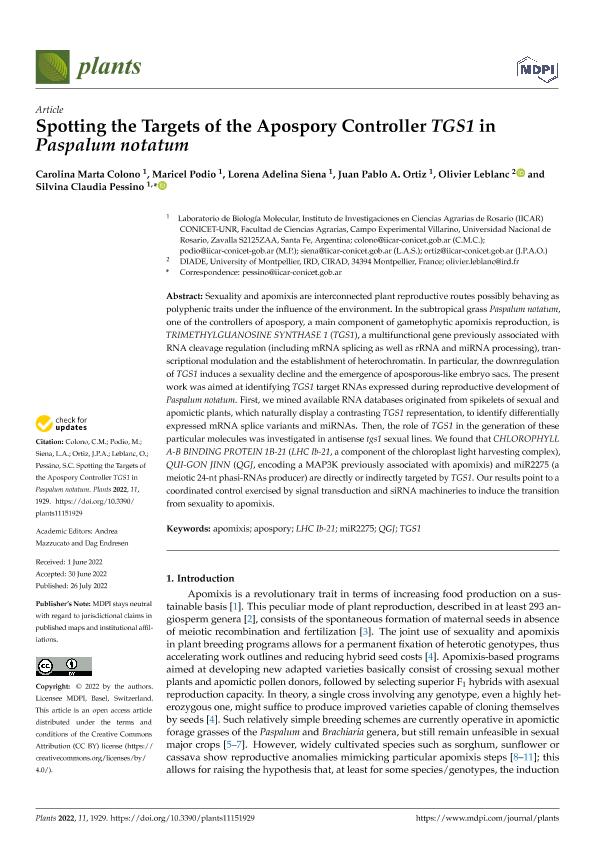Artículo
Spotting the Targets of the Apospory Controller TGS1 in Paspalum notatum
Colono, Carolina Marta ; Podio, Maricel
; Podio, Maricel ; Siena, Lorena Adelina
; Siena, Lorena Adelina ; Ortiz, Juan Pablo Amelio
; Ortiz, Juan Pablo Amelio ; Leblanc, Olivier; Pessino, Silvina Claudia
; Leblanc, Olivier; Pessino, Silvina Claudia
 ; Podio, Maricel
; Podio, Maricel ; Siena, Lorena Adelina
; Siena, Lorena Adelina ; Ortiz, Juan Pablo Amelio
; Ortiz, Juan Pablo Amelio ; Leblanc, Olivier; Pessino, Silvina Claudia
; Leblanc, Olivier; Pessino, Silvina Claudia
Fecha de publicación:
06/2022
Editorial:
MDPI
Revista:
Plants
ISSN:
2223-7747
Idioma:
Inglés
Tipo de recurso:
Artículo publicado
Clasificación temática:
Resumen
Sexuality and apomixis are interconnected plant reproductive routes possibly behaving as polyphenic traits under the influence of the environment. In the subtropical grass Paspalum notatum, one of the controllers of apospory, a main component of gametophytic apomixis reproduction, is TRIMETHYLGUANOSINE SYNTHASE 1 (TGS1), a multifunctional gene previously associated with RNA cleavage regulation (including mRNA splicing as well as rRNA and miRNA processing), transcriptional modulation and the establishment of heterochromatin. In particular, the downregulation of TGS1 induces a sexuality decline and the emergence of aposporous-like embryo sacs. The present work was aimed at identifying TGS1 target RNAs expressed during reproductive development of Paspalum notatum. First, we mined available RNA databases originated from spikelets of sexual and apomictic plants, which naturally display a contrasting TGS1 representation, to identify differentially expressed mRNA splice variants and miRNAs. Then, the role of TGS1 in the generation of these particular molecules was investigated in antisense tgs1 sexual lines. We found that CHLOROPHYLL A-B BINDING PROTEIN 1B-21 (LHC Ib-21, a component of the chloroplast light harvesting complex), QUI-GON JINN (QGJ, encoding a MAP3K previously associated with apomixis) and miR2275 (a meiotic 24-nt phasi-RNAs producer) are directly or indirectly targeted by TGS1. Our results point to a coordinated control exercised by signal transduction and siRNA machineries to induce the transition from sexuality to apomixis.
Palabras clave:
APOMIXIS
,
APOSPORY
,
LHC IB-21
,
MIR2275
,
QGJ
,
TGS1
Archivos asociados
Licencia
Identificadores
Colecciones
Articulos(IICAR)
Articulos de INST. DE INVESTIGACIONES EN CIENCIAS AGRARIAS DE ROSARIO
Articulos de INST. DE INVESTIGACIONES EN CIENCIAS AGRARIAS DE ROSARIO
Citación
Colono, Carolina Marta; Podio, Maricel; Siena, Lorena Adelina; Ortiz, Juan Pablo Amelio; Leblanc, Olivier; et al.; Spotting the Targets of the Apospory Controller TGS1 in Paspalum notatum; MDPI; Plants; 11; 15; 6-2022; 1-19
Compartir
Altmétricas



